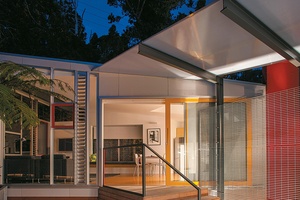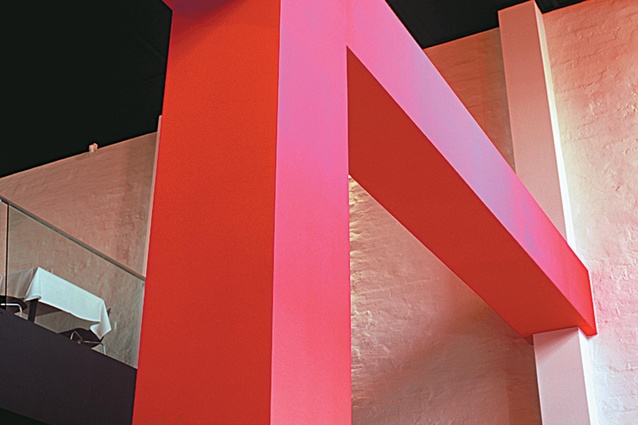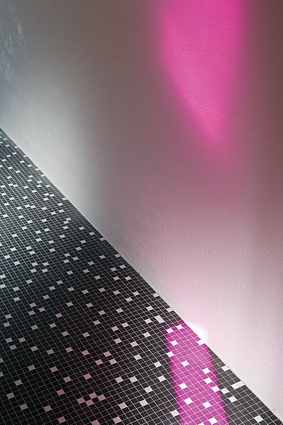Designer Profile: Penny Vernon
Urbis: When and how did you get involved in interior design?

Penny Vernon: I think all my life I’ve been drawing pictures. I was the second eldest of six children on a small farm in Raglan, near Hamilton, and I had an extraordinarily artistic mother who was always doing all kinds of things to try and make a very basic house better. She would dip fabric in size and put it on the wall and paint it – she was forever doing things. She was a wonderful seamstress and she was a dress designer as well as having six children. I guess I grew up drawing pictures in my mind of what I liked. That’s really what I go back to – that you can draw these pictures. I went to boarding school and I had an artistic interest but didn’t think I was good enough to go to Elam. In the Christmas holidays, Christopher Bede, who were photographers at the time and travelled the country, called in and they talked about the studio they had where they coloured photographs with an airbrush and so that’s what I did for two years.
Then I came home. My mother wasn’t well so I came home to help her and, at that time, I met my husband who farmed next door and we married, had three children and farmed for 10 years. During that time, I continued with the airbrushing for two photographers in Hamilton. I came to Auckland and I was at lunch one day with a friend in Pakuranga and she said ‘if you’re interested in interior design – before you go home, drive along Glenmore Road and there’s a house there you’ll notice. It’s an old farm cottage, it has a farm fence with roses on it, it has mounds in the garden with silver birches and daffodils – it belongs to Nanette Cameron and she teaches interior design at Tamaki College’. I saw this, went home and the following day I enrolled in her course and it just opened so many doors for me. It was amazing and this has happened to so many women with Nanette – she’s just an extraordinary person. We persuaded her to do a second year which I did. At this stage her course was growing considerably and she asked if I would help as an assistant, which I did for several years.
U: What was the basic curriculum that Nanette taught?
PV: We went out and bought paints and we started by doing the colour wheel. So the first term was basically colour. In those days it wasn’t important, to most people, what colour their household objects were. Times have changed so much and, at last, I found somebody who had the same feelings that I did – which was that it was important. Nanette is still a very close friend of mine today. Then my husband’s brother, who had been in England, came home in about 1973 with a partner Denis Cohn. When Denis’ dad died a couple of years later, he decided that he’d open an art gallery and I worked with him for five years there. That gave me passion in art and also taught me to look at a painting and buy it because you love the painting, not to put it in the room because it does something to the room. If you buy a painting it doesn’t matter where it goes. I also realised that Denis had an amazing eye and could pick talent. I thought I didn’t really have that. So I came back to interior design because we built an interesting house in Arthur Street with Pip Cheshire as the architect. I worked with him on that which was great because he loves hot colours, I like cold colours so we clashed and got this excitement going. At the same time, Pete Bossley was doing a wonderful house in Herne Bay, it’s known as the Barne’s house with a Frank Lloyd Wright theme and I worked on that too. So that really got me back into interior design and I think that was about 30 years ago and from that I grew my own business.
U: Can designer taste be learnt or is it just inherent, you either have it or you don’t?
PV: I don’t want to sound smug or anything but I do think you have it or you don’t. I think you can learn the basics and the colour wheel is the basics. When I have to put colours or patterns together – when it works you just think ‘wow’ – and if I had to refer to a textbook every time I solved a problem I don’t know how I’d do it. I don’t know why I choose colour sometimes. Something inside me says I think that should be a certain colour and I follow that usually.
U: Since you’ve mentioned colour, colour is invariably tricky. I think people are quite intimidated by it which perhaps means there’s a lot of beige around.
PV: I’m all for beige, I’ll start with beige and a lot of the colour is in the finishing touches. A wonderful client I’m still working with today, when I first worked with him we were working through these colours which were mainly off whites and this client turned to me and said ‘Penny where’s the colour?’ and I looked at him, he was a very smartly dressed man. I said, ‘look you’re wearing black shoes, black socks, black suit, you’ve even got a black raincoat. You have a white shirt and a wonderful tie. That’s what it’s all about’. He’s never questioned me since.
U: So your approach to colour then is, it’s the details, it’s the finishing touches. What are your tricks, do you have a palette of colours that you often come back to?
PV: Everyone has special feelings for colour and my job is to pull that out of somebody, because there’s no point in giving them a blue house if they hate blue. It takes quite a bit of time at the beginning to work with people. I’ll sometimes take people to a fabric importer, really just to watch them to see what they’ll go for, and that will give you a pretty good indication of what their feelings are. I’m also very lucky that I work with architects. There’s a few in particular I work with all the time so we’re in harmony as well. Pete Bossley gave me some very good advice in the early stages. He said no matter what you think or I think we must present a united front and I definitely always adhere to that. I listen to the architect, as well as the client, but you do find that a client is more comfortable with me and will say more than they will to the architect – I’m not on the pedestal that the architect is perhaps.
U: You’re well known for working with some of New Zealand’s top architects. Do you look at a space differently to architects?
PV: What I do find sometimes is that an architect comes in all excited at the beginning and then comes the chore of putting it all together. I often say to clients it’s a pity that architects don’t show all of their rubbish bin rather than just the completed drawings because it looks ever so simple and it isn’t. I sometimes find this the stage that I’m brought in to go through the plans again with the architect and the client, they’re revisiting their early thoughts which I find exciting and in a way I think it’s good for them. They’re going back, they’ve done all the hard work, they’re going back to the real beginning of what made this design.
U: You’ve been working in interior design for many years now, are there some elements like proportion or composition, colour wheel which are consistent all the way through or does interior design change over the years?
PV: It changes but the basics are always there. I love adding old to new and new to old but it’s got to be a connected to a certain design element. At the same time I like a bit of wit or a bit of fun. I think on the whole most of our houses are a little too serious.
U: How do you add a bit of wit to a house?
PV: Unfortunately a lot of that was my husband and he’s no longer here. He shaped me a lot.
U: New Zealanders often seem quite timid with their interiors. Is your role to bring out a little bit of boldness?
PV: So much goes into the cost of a house and, I think on the whole, men hold the purse strings. I’m not against men, by any means, but there are certain things sometimes that have an image and are expensive and they go in in the early days, like granite benches. So it may seem frivolous to go and spend money on a painting or furniture or the odd things which often make the home but they come at the end when the budget is blown. I don’t believe a house is finished when you move in. I believe it’s just starting. I’ll often suggest people move in with their old furniture because then we can work out how that house is going to work. I think it takes a year, two years at least to get a house finished, if ever.
U: So is a bit of mess good for a house?
PV: I think so because it’s life. Absolutely.
U: Do you work in a different capacity with different clients? You choose or help them choose colours and the furnishings?
PV: Sometimes people just want a few colours put together which is not that satisfying really. I think a great skill is to move into a room that perhaps needs furniture recovered or new curtains and to be able to do that without making everything else look obsolete.
U: What or who are your influences?
PV: Well I don’t know any architect who gets space, movement and life space better than Malcolm Walker. You’re never in a Malcolm Walker-designed house thinking ‘gosh we should be in the other room’ or ‘this isn’t quite working’. As far as I know people only sell his houses when they have to move on, because they really do work.
Claire Chambers is another architect I work with and she’s a wonderful planner of things and I certainly enjoy working with her. The last house I worked on was with Malcolm Taylor who I found very interesting – so I’m very lucky in that way. You can get to know so many talented people.
U: Do you do commercial work?
PV: Only if a residential client also has a commercial space. A few years ago we did the Silk Drawer in town. Malcolm, my husband and I worked on that and that was because I’d helped with her own house. That was a lot of fun.
U: What did your husband do?
PV: He started as a farmer, then we moved to Auckland and he worked in the motor industry for many years. He was a plant manager but he could see the writing on the wall as far as the assembly of cars in New Zealand, so he resigned from that. We still owned the farm and he thought he’d put a lot of time into that but it was just at the time when farming really went down so he couldn’t. So he started working with me solving problems – he was just wonderful at helping peope. Often a building is finished but there are one or two things that need tweaking and it needs a good mind to do it and that’s what he did. Malcolm Walker loved working with him. He would always add that little bit of wit too.
U: With clients who are couples, if they have different design sensibilities, can that be quite difficult?
PV: Definitely, diplomacy is an enormous part of it, but I always like to meet husbands too. They also have to live in the house and it’s terribly important that they have a say I think. Some jobs I’m working with husbands more than wives.
U: As the world changes and women are often the main breadwinner, has that changed how you deal with clients?
PV: Definitely. Also more and more men are cooking so the kitchen becomes an important part of the house for them as well as women. Men love lighting. I know Robin my husband loved what you could do with lighting. Generally today both clients are working. if you’re both working – coming home, picking up the children, you’re getting meals, you’re getting yourself away the next day, trying to make some sort of life at the weekend, you want things easy and comfortable.
U: What do you think is special about design and architecture in New Zealand?
PV: I suppose I’ve seen a change in my life that the houses now flow to the outside. We always hope for a better summer but we do build our houses with our barbecues and that sort of thing. I suppose that’s unique to New Zealand. Over recent years too, more and more people have built the beach houses so that your life is even more fragmented because you’re busy in the week and come Friday you pack up and you go away and you come back on Sunday night. I just wish people would keep in mind that bunking down and baching is a good way to have a beach house. I remember Claire Chambers saying years ago, ‘the fact that we are away from home means we’re casual, everyone brings something, you put it in the middle of the table’. I think more and more we’re doing this now. Formal dinner parties are not very often done and the big table in the kitchen is part of life.
U: That’s one of the wonderful things about your house, there’s no island. There’s a big dining room table in the middle of the kitchen.
PV: We didn’t have room for an island here. It was either an island or a big table and I still think the island works very, very well. What we’re seeing today, and I think it works very well in kitchens, is the scullery behind a door so all your dishes can be loaded out there and you still have the pristine kitchen but not all houses have that space.
U: Why are our house interiors important? Why do we spend money and time on them?
PV: Actually, we had just this discussion the other night coming back from going to the Sydney Biennale and then to the new gallery in Hobart Mona. Why is art important? We can’t really say, but personally I don’t think anything gives me more joy now than looking at a great art gallery or looking at a great painting. And the home is nesting really isn’t it? It’s one of the most important things and particularly for me now I am so glad that although this is a big house, it still feels very good to be in.













